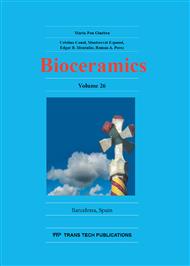[1]
Y. Zuo, F. Yang, J.G. Joop, Y. Li, J.A. Jansen, Incorporation of biodegradable electrospun fibers into calcium phosphate cement for bone regeneration. Acta Biomaterialia. 6(2010) 1238–1247.
DOI: 10.1016/j.actbio.2009.10.036
Google Scholar
[2]
I. Demnati, et al, Hydroxyapatite coating on titanium by a low energy plasma spraying mini-gun. Surface & Coatings Technology. 206 (2012) 2346–2353.
DOI: 10.1016/j.surfcoat.2011.10.025
Google Scholar
[3]
X. Miao, et al, Preparation and characterization of interpenetrating phased TCP/HA/PLGA composites. Materials Letters. 59 (2005) 4000-4005.
DOI: 10.1016/j.matlet.2005.07.062
Google Scholar
[4]
D.V.V. Rani, Osteointegration of titanium implant is sensitive to specific nano structure morphology. 8 (2012) 1976-(1989).
Google Scholar
[5]
M.P. Stevens, Polymer Chemistry: An Introduction, Oxford University Press, New York, (1999).
Google Scholar
[6]
C.C. Chen, J.Y. Chueh, H. Tseng, H.M. Huang, S.Y. Lee, S. Preparation and characterization of biodegradable PLA polymeric blends. Biomaterials. 24 (2003)1167-1173.
DOI: 10.1016/s0142-9612(02)00466-0
Google Scholar
[7]
Y. Lipatov, Polymer blends and interpenetrating polymer networks at the interface with solids. Progress in Polymer Science. 27 (2002) 1721-1801.
DOI: 10.1016/s0079-6700(02)00021-7
Google Scholar
[8]
K.Y. Lee, L. Jeong, Y.O. Kang, S.J. Lee, W.H. Park, Electrospinning of polysaccharides for regenerative medicine. Advanced Drug Delivery Reviews. 61(2009) 1020-1032.
DOI: 10.1016/j.addr.2009.07.006
Google Scholar
[9]
F. Chen, F. Q. L, Tang, Y.J. Zhu, K.W. Wang, M.L. Zhang, W.Y. Zhai, J. Chang, Hydroxyapatite nanorods/poly(vinyl pyrolidone) composite nanofibers, arrays and three-dimensional fabrics: Electrospun preparation and transformation to hydroxyapatite nanostructures. ActaBiomaterialia. 6 (2010).
DOI: 10.1016/j.actbio.2010.02.015
Google Scholar
[10]
D.R. Marques, L.A. Santos, V. C. Sousa, P.R.S. Sanches. P, Brazil. Patent 0000221010682444. (2011).
Google Scholar
[11]
S. Joschek, B. Nies, R. Krotz. A, GoKpferich, Chemical and physicochemical characterization of porous hydroxyapatite ceramics made of natural bone. Biomaterials. 21(16) (2000) 1645-1658.
DOI: 10.1016/s0142-9612(00)00036-3
Google Scholar
[12]
J.L.M. Machado, Desenvolvimento de cimento ósseo de fosfato de cálcio para o crescimento de tecidos, Dissertação de mestrado, Federal University of Rio Grande do Sul, (2007).
Google Scholar
[13]
S.H. Rhee, Synthesis of hydroxyapatite via mechanochemical treatment. Biomaterials 23 (2002) 1147–1152.
DOI: 10.1016/s0142-9612(01)00229-0
Google Scholar
[14]
R.M. Tromme, L.A. Santos, C.P. Bergmann, Alternative technique for hydroxyapatite coatings. Surface & Coatings Technology. 20 (2007) 9587–9593.
DOI: 10.1016/j.surfcoat.2007.04.028
Google Scholar
[15]
G. Mestres. G, C. Le Van. C, M.P. Ginebra, Silicon-stabilized a-tricalcium phosphate and its use in a calcium phosphate cement: Characterization and cell response. Acta Biomaterialia 8 (2012) 1169–1179.
DOI: 10.1016/j.actbio.2011.11.021
Google Scholar
[16]
J. Zhao. Rietveld refinement of hydroxyapatite, tricalcium phosphate and biphasic materials prepared by solution combustion method. Ceramics International 40 (2014): 3379–3388.
DOI: 10.1016/j.ceramint.2013.09.094
Google Scholar
[17]
D. R. Marques et al, Analysis of Poly(Lactic-co-Glycolic Acid)/Poly(Isoprene) Polymeric Blend for Application as Biomaterial. Polímeros. 23 (2005) 579-584.
DOI: 10.4322/polimeros.2013.099
Google Scholar
[18]
W.A. R Neto, et al, Influence of the microstructure and mechanical strength of nanofibers of biodegradable polymers with hydroxyapatite in stem cells growth. Electrospinning, characterization and cell viability, Polymer Degradation and Stability. 97(2012).
DOI: 10.1016/j.polymdegradstab.2012.03.048
Google Scholar


